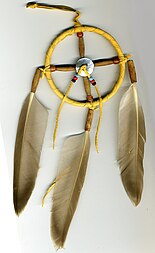Medicine Wheel
A medicine wheel ( dt: . Medicine wheel ) is a sacred place of multiple cultures of the Plains Indians . They are located in the northern Great Plains , northern United States, and southern Canada . In stylized form, the medicine wheel is used as a religious symbol by the Lakota in particular . As a symbol, it was also picked up in esoteric circles, especially in the variant of Sun Bear .
Appearance and Distribution
There are tens of thousands of indigenous stone formations in the Great Plains. As Medicine Wheel a Cairn as a key: those that have at least two of the following characteristics apply hub , one or more (often concentric) circles and at least two spoke-shaped stone rows. Of this type, about 135 are known (depending on the interpretation in the event of severe destruction), 66 alone are in the Canadian province of Alberta . Others are known from Wyoming , Montana , South Dakota and Saskatchewan .
The most famous location is the Big Horn Medicine Wheel in the Bighorn National Forest , a National Forest , in the Bighorn Mountains between Powell and Sheridan in Wyoming. It is approximately 23 m in diameter and has 28 spokes and is dated between 1400 and 1700. It was designated a National Historic Landmark in May 1970 and is maintained by the US Forest Service .
meaning
Medicine Wheels have been dated up to 5000 years old, but some were created in historical times after contact with whites. These recent Medicine Wheels are from the Blackfoot and were believed to have been put on as part of ceremonies following the death of a prominent warrior. Some wheels seem to have been used for a long time and may have been expanded. They could be related to the sun dance . Additional cultic functions and meanings have been lost. They preserve today's Indian cultures as traditional places of worship of their ancestors and regard them as holy places. The word component " medicine " does not stand for medicine, as is generally the case in the culture of North American Indians, but for the "mysterious, transcendent power behind all visible phenomena".
There are various theories about the construction of some Medicine Wheels as astronomical instruments. At some locations, lines of sight from the center to other distinctive shapes have been identified that run in the direction of the point at which the sun rises at the summer solstice and other locations relevant to the calendar . In Valley City , North Dakota , the local state university created a Medicine Wheel and other stone formations in the so-called Medicine Wheel Park to demonstrate the facility's capabilities as an astronomical observatory.
Lakota symbolism
For the Lakota, the medicine wheel consists of a four-spoke ring. The number four has a special meaning in their mythology, it stands for the cardinal points and the central values woksape (wisdom), woohitika (bravery), wowacintanka ( fortitude ) and wacantognaka (generosity) of the people. It is often associated with animal symbols. The wheel is used in traditional ceremonies and, more recently, has been understood as a symbol for the people and culture in artistic representations.
The emblem of Sinte Gleska University in Rosebud , South Dakota , named after Chief Spotted Tail , uses the medicine wheel in traditional colors of the people and with a central buffalo skull and four eagle feathers. The Lakota medicine wheel and the stone setting play a visual role in the documentary miniseries " Into the West " (2005) by Steven Spielberg , where the symbol is set in relation to the wheels on the white wagon , which is here synonymous with the urge to expand and progress can be used.
literature
- John Brumley: Medicine Wheels . In: Guy Gibon (Ed.): Archeology of Prehistoric Native America . New York & London, Garland Publishing, 1998, ISBN 0-8153-0725-X , p. 68f, 509f
- John Brumley: Medicine Wheels on the Northern Plains - A Summary and Appraisal . Edmonton, Archaeological Society of Alberta, 1988
Web links
- Royal Alberta Museum: FAQ: What is a Medizine Wheel? - with schemes of various types
- National Park Service: Medicine Wheel National Historic Landmark
- Valley City State University: The Medicine Wheel Park
Individual evidence
- ↑ a b Royal Alberta Museum: FAQ: What is a Medicine Wheel? ( Memento of the original from March 9, 2014 in the Internet Archive ) Info: The archive link was inserted automatically and has not yet been checked. Please check the original and archive link according to the instructions and then remove this notice.
- ↑ a b Wyoming State Historic Preservation Office: Medicine Wheel / Medicine Mountain National Historic Landmark with linked National Historic Landmark File of the National Park Service, 2011
- ↑ Listing of National Historic Landmarks by State: Wyoming. National Park Service , accessed March 14, 2020.
- ↑ Unless otherwise stated, this chapter is based on: Royal Alberta Museum: FAQ: What is a Medicine Wheel? ( Memento of the original from December 27, 2007 in the Internet Archive ) Info: The archive link was inserted automatically and has not yet been checked. Please check the original and archive link according to the instructions and then remove this notice.
- ^ Norbert Kohnen: Keyword: medicine man. In: Encyclopedia of Medical History. Werner E. Gerabek, Bernhard D. Haarge, Gundolf Keil a . Wolfgang Wegner (Ed.), Walter de Gruyter, Berlin 2005, ISBN 3-11-015714-4 . P. 956
- ↑ Unless otherwise stated, this chapter is based on: Nizhoní Gollner-Marin, Martin: Ikce Wicasa - The Lakota's struggle for survival and the love of wisdom . Inaugural dissertation to obtain a doctorate from the Philosophical Faculties of the Albert Ludwig University of Freiburg i.Br., 1994, (also online: Ikce Wicasa (PDF; 2.4 MB) )
Coordinates: 44 ° 49 ′ 34 " N , 107 ° 55 ′ 18" W.


